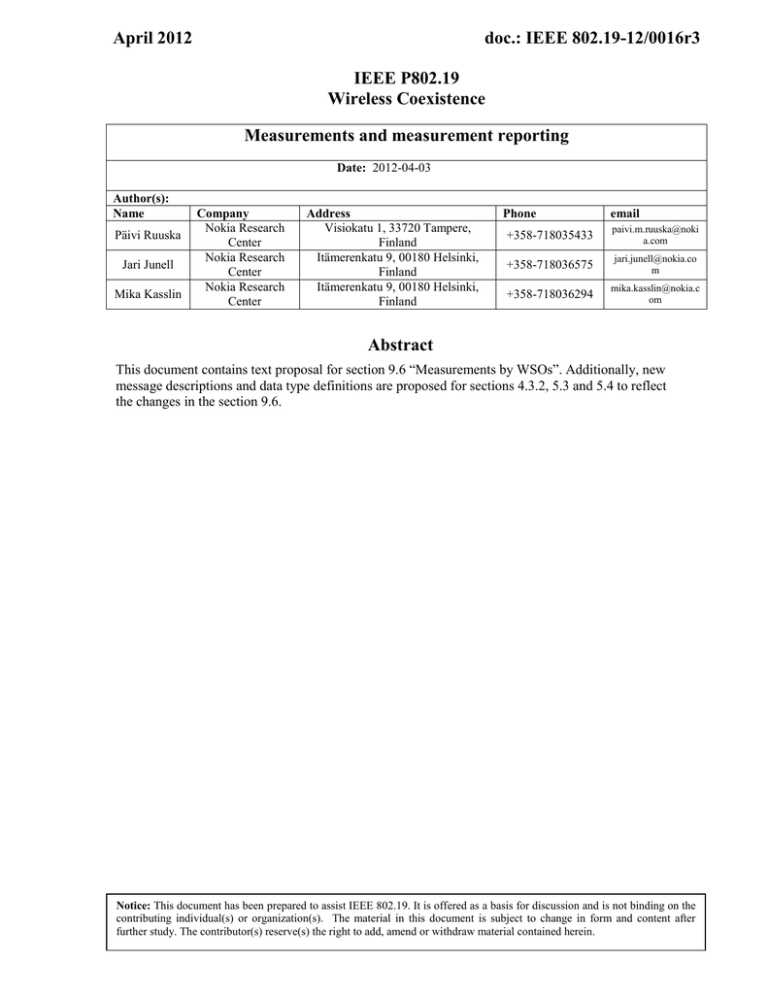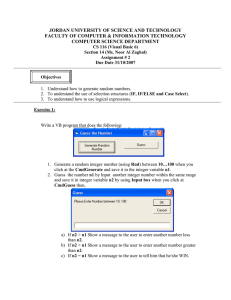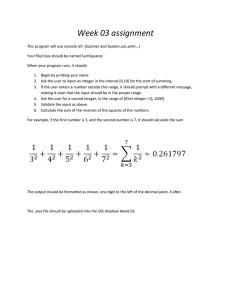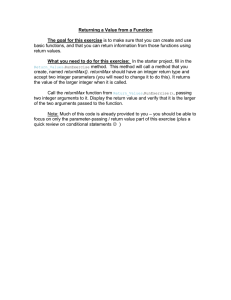April 2012 doc.: IEEE 802.19-12/0016r3 IEEE P802.19
advertisement

April 2012
doc.: IEEE 802.19-12/0016r3
IEEE P802.19
Wireless Coexistence
Measurements and measurement reporting
Date: 2012-04-03
Author(s):
Name
Päivi Ruuska
Jari Junell
Mika Kasslin
Company
Nokia Research
Center
Nokia Research
Center
Nokia Research
Center
Address
Visiokatu 1, 33720 Tampere,
Finland
Itämerenkatu 9, 00180 Helsinki,
Finland
Itämerenkatu 9, 00180 Helsinki,
Finland
Phone
email
+358-718035433
paivi.m.ruuska@noki
a.com
+358-718036575
jari.junell@nokia.co
m
+358-718036294
mika.kasslin@nokia.c
om
Abstract
This document contains text proposal for section 9.6 “Measurements by WSOs”. Additionally, new
message descriptions and data type definitions are proposed for sections 4.3.2, 5.3 and 5.4 to reflect
the changes in the section 9.6.
Notice: This document has been prepared to assist IEEE 802.19. It is offered as a basis for discussion and is not binding on the
contributing individual(s) or organization(s). The material in this document is subject to change in form and content after
further study. The contributor(s) reserve(s) the right to add, amend or withdraw material contained herein.
Submission
page 1
Päivi Ruuska, Nokia
April 2012
doc.: IEEE 802.19-12/0016r3
Editorial instructions: Replace section 9.6 in the DF2.08 with the following section and update section
numbering as required.
9.6 Measurements and measurement reporting
A CM has means to obtain measurement results from all the CEs it serves. The CM shall be able to
configure the measurement reporting. The CM may request the CE to provide one-time measurements or
scheduled measurements by sending a measurement request to the CE (as defined in 5.2.8).
A WSO performs measurements according to its capabilities. A WSO provides measurement results to
the CE and the CE shall form the IEEE 802.19.1 measurement reports out from the measurement results.
In the CE registration the CE shall indicate the CM which of the measurement reports it supports with the
WSO. The measurement reports are defined in section 5.3.9.
The following sub-clauses define the measurement types and the way how the measurement report fields
are filled with each measurement type.
9.7.1 SINR measurement
The signal to interference plus noise ratio (SINR) measurement indicates the ratio of the received signal
power (S-IN) to the average interference plus noise power (IN):
SINR= (S-IN) / IN,
where
S = Received signal strength (RSS) measured at the reference point of the measuring device during
reception of own network transmissions
IN = RSS measured at the reference point of the measuring device during periods when the measuring
device considers the channel to be idle
The SINR is indicated in dB and it is scaled in steps of 0.5 dB to obtain the SINR values, which cover the
range from –10 dB (value = 0) to + 117 dB (value = 254). The value 255 indicates that SINR is not
available.
9.7.2 FER measurement
The frame error rate (FER) measurement indicates the ratio of the frames that the measuring device
received with errors to the total number of frames received by the measuring device. The measurement is
carried over all the wireless links the measuring device has during the measurement period.
The FER is indicated as the percentage, linearly scaled with 255 representing that all frames have errors
(FER=100%). The percentage shall be computed using the following formula:
FER = Integer ((number of frames with errors / number of measured frames) × 255)
9.7.3 Interference plus noise floor measurement
The interference plus noise floor (IPNF) measurement is an indication of the average interference plus
noise power measured at the reference point of the measuring device during periods when the measuring
device considers the channel to be idle.
The IPNF is indicated in dBm and is scaled in steps of 0.5 dBm to obtain values, which cover the range
from –134 dBm (value = 0) to – 7 dBm (value = 254). The value 255 indicates that IPNF is not available.
Submission
page 2
Päivi Ruuska, Nokia
April 2012
doc.: IEEE 802.19-12/0016r3
9.7.4 Signal distribution measurement
The signal distribution measurement indicates the ratio of time that received signal is within each defined
received signal level range. The received signal level is measured at the reference point of the measuring
device and in this measurement type any detected signal is considered.
The signal distribution measurement report contains a set of signal level ranges and indications of
proportion of detected signal within the ranges. The signal level ranges are indicated with means of level
thresholds that determine signal level ranges that are all equal in size. The proportion of detected signal
within each signal level range is indicated as the percentage of time the measuring device has detected
signal within the signal level range. The percentage is computed using the following formula:
Signal distribution within a signal level range = Integer ((time that the received signal is between
the thresholds defined for the signal level range / measurement duration) × 255)
Figure 1 shows an example of thresholds and the proportion of detected signal within each signal level
range.
Figure 1: An example of signal distributions
9.7.5 Spectrum measurement
The spectrum measurement provides the frequency response as perceived by the measuring device. The
measurement is performed at the reference point of the measuring device.
The spectrum measurement report contains the number of sub-channels, the received signal strength for
each sub-channel, and the measurement bandwidth.
The number of sub-channels indicates into how many sub-channels the measured and reported bandwidth
is divided. The number of sub-channels value is indicated in the range from 1 to 4095. This field also
indicates the number of the fields indicating the received signal strength for the sub-channel in the frame.
Submission
page 3
Päivi Ruuska, Nokia
April 2012
doc.: IEEE 802.19-12/0016r3
The received signal strength for the sub-channel is defined as described for the received signal strength
for the measured bandwidth. The received signal strength for the sub-channels is indicated in dBm and is
scaled in steps of 0.5 dBm to obtain values, which cover the range from –134 dBm (value = 0) to – 7 dBm
(value = 254). The frame contains a field for each sub-channel.
power/magnitude
The measurement bandwidth is indicated in kHz.
sub-channel
frequency
measured bandwidth
Figure 2: An example of frequency response, measured bandwidth and sub-channel
9.7.6 Channel load measurements
The channel load measurement provides a channel utilization measure as seen by the measuring device.
Two different channel load measurement types are defined: Channel load of the network in which the
measuring device operates and Total channel load.
9.7.6.1 Own network channel load
Own network channel load is defined as the percentage of time that the measuring device assesses the
channel to be utilized by its own network.
The own network channel load is indicated as the percentage of time, linearly scaled with 255
representing that the channel is 100% utilized by the own network. This percentage shall be computed
using the following formula:
Own network channel load = Integer((time that the channel is occupied by the own network /
measurement duration) × 255)
9.7.6.2 Total channel load
Total channel load is defined as the percentage of time that the measuring device assesses the channel to
be utilized.
The total channel load is indicated as the percentage of time, linearly scaled with 255 representing that the
channel is assessed to be utilized 100% of the measurement time. This percentage shall be computed
using the following formula:
Total channel load = Integer((channel utilized time / measurement duration) × 255)
Submission
page 4
Päivi Ruuska, Nokia
April 2012
doc.: IEEE 802.19-12/0016r3
9.7.7 Measurements detecting other spectrum users
These measurements enable a measuring device to report operation of other wireless transmitters, which it
has detected on the TV band spectrum. A CE that supports these measurement reports is connected to a
WSO that has capabilities to recognize the type of the other wireless transmitter that it reports. As an
example the measuring device may have spectrum sensor with feature detector capable of detecting
specific radio access technology, or it may recognize the operation of other wireless transmitters because
it supports the same radio access technology.
RAT of the detected wireless transmitter is indicated with technology type field.
4.3.2 COEX_MEDIA_SAP
Editorial instructions: Replace the measurement related data types in section 4.3.2 of the DF2.08 from
line 6 through line 46 on draft page 37 with the following.
MeasurementSchedule ::= SEQUENCE {
measStartTime
REAL,
numberOfMeasurements
INTEGER,
timeBetweenMeasurements REAL
}
FrequencyIndication ::= SEQUENCE {
startFreq
INTEGER,
stopFreq
INTEGER
}
ChannelIndication ::= SEQUENCE OF INTEGER
MeasurementFreq ::= CHOICE {
startStopFreq
FrequencyIndication,
channelNumber
ChannelIndication
}
MeasurementType ::= ENUMERATED {
sinr,
fer,
ipnf,
signalDistribution,
spectrum,
ownNetworkChannelLoad,
totalChannelLoad,
otherUsers
}
MeasurementDescription ::= SEQUENCE {
measType
MeasurementType,
measSchedule
MeasurementSchedule,
measFreq
MeasurementFreq
}
SinrReport ::= SEQUENCE {
measBW
REAL,
sinr
REAL
}
FerReport ::= SEQUENCE {
Submission
page 5
Päivi Ruuska, Nokia
April 2012
fer
doc.: IEEE 802.19-12/0016r3
REAL
}
IpnfReport ::= SEQUENCE {
measBW
REAL,
ipnf
REAL
}
SignalDistributionReport ::= SEQUENCE {
measBW
REAL,
lowEndOfSignalLevelRange
REAL,
numberOfSignalLevelRange
INTEGER,
widthOfSignalLevelRange
REAL,
signalProportionPerRange
SEQUENCE OF REAL
}
SpectrumReport ::= SEQUENCE {
measBW
REAL,
lowEndOfReportedBandwidth REAL,
numberOfSubchannels
INTEGER,
widthOfSubchannel
REAL,
signalStrengthPerSubchannel
SEQUENCE OF REAL
}
ChannelLoadReport ::= SEQUENCE {
load
REAL
}
OtherUsersReport ::= SEQUENCE {
technologyType
NetworkTechnology
}
MeasurementReport ::= CHOICE {
sinrReport
ferReport
ipnfReport
signalDistributionReport
spectrumReport
ownNetworkChannelLoadReport
totalChannelLoadReport
otherUsersReport
}
SinrReport,
FerReport,
IpnfReport,
SignalDistributionReport,
SpectrumReport,
ChannelLoadReport,
ChannelLoadReport,
OtherUsersReport
MeasurementResult ::= SEQUENCE OF SEQUENCE {
measDescription
MeasurementDescription,
measReport
MeasurementReport,
}
5.3 Messages
Editorial instructions: Replace the measurement related messages in section 5.3 of the DF2.08 from line
27 through line 35 on draft page 65 with the following.
-- Requesting and obtaining measurement procedure messages
MeasurementRequest ::= SEQUENCE {
-- Measurement description
measDescription
MeasurementDescription
Submission
page 6
Päivi Ruuska, Nokia
April 2012
doc.: IEEE 802.19-12/0016r3
}
MeasurementResponse ::= SEQUENCE OF SEQUENCE {
-- Measurement result in form of measurement reports
measDescription
MeasurementDescription,
measReport
MeasurementReport,
}
5.4 Data types
Editorial instructions: Replace the measurement related data types in section 5.4 of the DF2.08 from line
36 on draft page 72 through line 15 on draft page 73 with the following.
MeasurementSchedule ::= SEQUENCE {
measStartTime
REAL,
numberOfMeasurements
INTEGER,
timeBetweenMeasurements REAL
}
FrequencyIndication ::= SEQUENCE {
startFreq
INTEGER,
stopFreq
INTEGER
}
ChannelIndication ::= SEQUENCE OF INTEGER
MeasurementFreq ::= CHOICE {
startStopFreq
FrequencyIndication,
channelNumber
ChannelIndication
}
MeasurementType ::= ENUMERATED {
sinr,
fer,
ipnf,
signalDistribution,
spectrum,
ownNetworkChannelLoad,
totalChannelLoad,
otherUsers
}
MeasurementDescription ::= SEQUENCE {
measType
MeasurementType,
measSchedule
MeasurementSchedule,
measFreq
MeasurementFreq
}
SinrReport ::= SEQUENCE {
measBW
REAL,
sinr
REAL
}
FerReport ::= SEQUENCE {
fer
REAL
}
IpnfReport ::= SEQUENCE {
Submission
page 7
Päivi Ruuska, Nokia
April 2012
measBW
ipnf
doc.: IEEE 802.19-12/0016r3
REAL,
REAL
}
SignalDistributionReport ::= SEQUENCE {
measBW
REAL,
lowEndOfSignalLevelRange
REAL,
numberOfSignalLevelRange
INTEGER,
widthOfSignalLevelRange
REAL,
signalProportionPerRange
SEQUENCE OF REAL
}
SpectrumReport ::= SEQUENCE {
measBW
REAL,
lowEndOfReportedBandwidth REAL,
numberOfSubchannels
INTEGER,
widthOfSubchannel
REAL,
signalStrengthPerSubchannel
SEQUENCE OF REAL
}
ChannelLoadReport ::= SEQUENCE {
load
REAL
}
OtherUsersReport ::= SEQUENCE {
technologyType
NetworkTechnology
}
MeasurementReport ::= CHOICE {
sinrReport
ferReport
ipnfReport
signalDistributionReport
spectrumReport
ownNetworkChannelLoadReport
totalChannelLoadReport
otherUsersReport
}
Submission
SinrReport,
FerReport,
IpnfReport,
SignalDistributionReport,
SpectrumReport,
ChannelLoadReport,
ChannelLoadReport,
OtherUsersReport
page 8
Päivi Ruuska, Nokia


